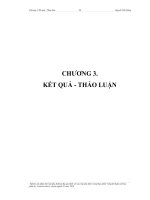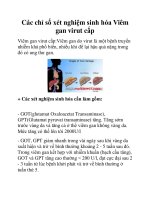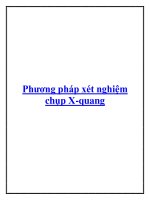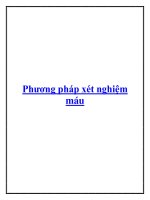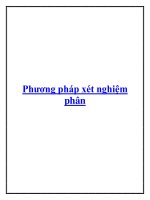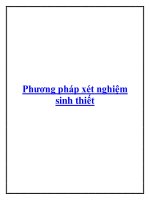các phương pháp xét nghiệm sinh hoá
Bạn đang xem bản rút gọn của tài liệu. Xem và tải ngay bản đầy đủ của tài liệu tại đây (2.12 MB, 21 trang )
BIOCHEMISTRY
Analysis and methods
Clinical Laboratory
is a place designed with equipments, chemicals and supplies to perform tests on patient samples such
as blood, body fluids, urine, and feces and must be licensed to operate.
Body fluids
Disease groups and diagnostic index
Medlatec source: />
Disease group
(mục 3)
• Parameters
Sample types, sampling, storage and process
(mục 1.1-1.4, mục 2)
• Affecting factors
• Sampling precautions
• Sample status and result
Reference parameters
(mục 4,5)
Major analytical methods
1.Spectroscopy
NMR (nuclear magnetic resonance)
Mass spectrometry
UV-VIS
Major analytical methods
2. Chromatography
LC-MS
GC-MS
Major analytical methods
2. Chromatography
LC-MS/MS chromatogram of a whole blood sample fortified with the analytes –
determination of fentanyl content
Major analytical methods
2. Chromatography
ion exchange column
protein separation based on net charge of the
protein.
Affinity chromatography
many proteins has affinity for specific chemical groups. For
example, the plant protein concanavalin A is a carbohydratebinding protein that has affinity for glucose.
Major analytical methods
3. Electrophoresis
• If a sample of protein is placed between two electrodes, positively
charged ions will move towards a negatively charged electrode.
Negatively charged ions will move towards a positively charged
electrode
• The rate depends on the size and charge on the ions: larger ions will
move more slowly; highly charged ions will move more quickly.
Therefore the ions are separated as the electric field is applied.
Major analytical methods
4. Immunoassay
VERY
SPECIFIC
BINDING
Major analytical methods
4. Immunoassay
direct ELISA
indirect ELISA
is used to detect the presence of
antibody e.g: HIV)
antibody must bind specifically to 2
things
sandwich ELISA
is used to detect antigen rather than
antibody.
Major analytical methods
5. PCR Polymerase Chain Reaction
/>
Major analytical methods
5. PCR Polymerase Chain Reaction
COVID PCR test
/>
COVID antigent test
/>
Major analytical methods
6. Cell culture method
investigate the biology, biochemistry, physiology (e.g., aging) and metabolism of wild-type cells and diseased cells.
/>
Major analytical methods
7. Flow cytometry
Flow Cytometry is a technique used to detect and measure physical and chemical characteristics of a population of
cells or particles
/>
Analytical sections in the lab
1. Hematology analysis (huyết học)
2. Biochemical analysis (sinh hoá)
3. Immuno-analysis (miễn dịch)
1. Hematology analysis
Purpose : />Hematology analyzer
Principle:
/> />
Peripheral blood cells analysis
Xét nghiệm tế bào máu ngoại vi
Purpose: />Instrument and parameters />Blood bank analyzer
Máy nhóm máu tự động
blood type principle: />Instrument and parameters : />
Coagulant analyzer
Máy đông máu tự động STA R MAX / Pháp
Purpose: diagnose the disease of bleeding and thrombus: /> />
Instrument and parameters : />
2. Biochemical analysis
Purpose
/>
Blood biochemical analysis
/>
Urine biochemical analysis
/>
e.g.: Urine analysis 14 parameters Urit 500C
/>
parameters: H, Nitrite, Ascorbic Acid, Protein, Specific Gravity, Blood, Glucose,Bilirubin,
Urobilinogen, Ketone, Leucocytes
3. Immuno-analysis
Purpose
/>
Principle
/> />
Instrument and parameter
Máy miễn dịch tự động Lumipulse G1200/Nhật Bản
•
Hệ thống tự động hồn tồn Cobas 8100
- Máy miễn dịch tự động Cobas e801
•
Hệ thống tự động hồn tồn Abbott A3600- Máy miễn dịch
tự động Architect i2000SR
•
Hệ thống Elisa tự động:
- Máy xét nghiệm miễn dịch tự động LIAISON XL
- Máy xét nghiệm miễn dịch tự động LIAISON
•
Summary
Learning goal:
understand the methods of analysis in biochemistry in the setting of research and clinical lab, including:
• diseases and relevant diagnosis methods
• sampling and handling
• relevant instruments and their working principles
• how to compare result with reference parameters
available working position: clinical technicians, biochemical lab researcher,
clinical instrument sales, supplies and instruments purchasing
open questions: compare the task of clinical chemist vs pharmaceutical chemist? what is the transferrable skills?
/>hrome..69i57.11787j0j7&sourceid=chrome&ie=UTF-8
/>emist+do&aqs=chrome..69i57j0i22i30l3j0i390l3.22666j1j7&sourceid=chrome&ie=UTF-8
Homework
Apply what you have learn and present a plan to diagnose:
•
•
•
•
•
Pick a disease
Choose the set of diagnostic tests, sampling methods
What are the relevant instruments for those tests
What are the working principles of these instruments
Interpretation of the result regarding the referencing parameters
